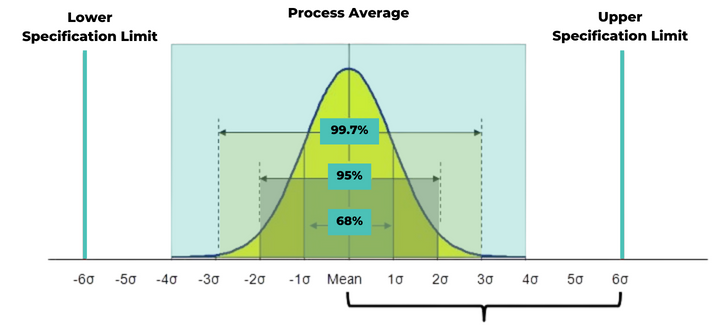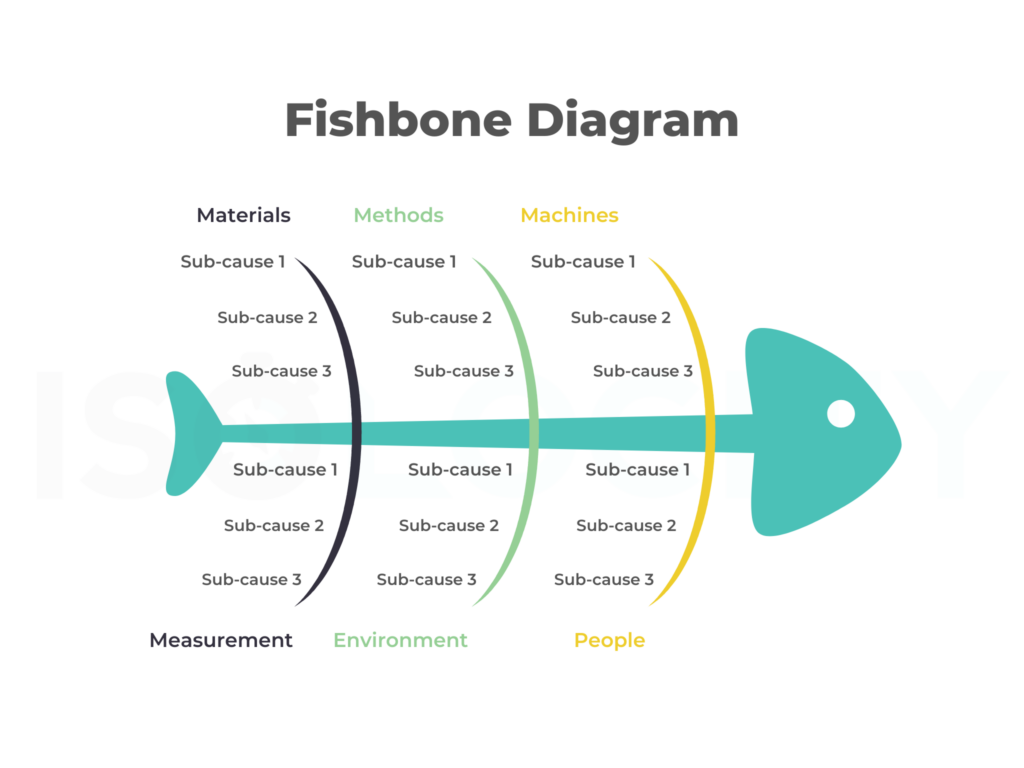Regarding methods for making processes better, Six Sigma is the clear leader when it comes to quality and speed. Six Sigma has become a term for success in many fields since it was created by Motorola in the 1980s. Its ideas have changed many fields, such as manufacturing, biomedicine, and healthcare, raising standards of work and making customers happier. But this guide goes into detail about answering the most-asked question about Six Sigma, i.e., “What are the six steps of Six Sigma?” The six steps of Six Sigma are, Define, Measure, Analyze, Improve, Control, and Verify.
The term “Six Sigma” originates from the concept that the standard deviation (Sigma) is exceptionally small. This allows for six standard deviations to comfortably fit on each side of a bell-shaped curve. It signifies remarkable precision. In defect metrics, achieving Six Sigma equates to a mere 3.4 defects per million opportunities.

Quality management software, such as Isolocity, plays a pivotal role in modernizing and optimizing quality management processes across industries. With the rise of methodologies like Six Sigma, organizations are increasingly turning to technology solutions to streamline their quality initiatives and drive continuous improvement.
But today we delve into the six steps of Six Sigma. We will explore their application, significance, and real-world examples.
Lean Six Sigma Tools: Digital QMS Live Webinar
Missed the webinar? No worries. Now you can watch the recorded session here.
Download the Six Sigma Webinar Presentation from here
Prefer Video Over Text? Check This Out!
Six Steps of Six Sigma
1. Define
The six steps of Six Sigma start with “Define”. In Six Sigma, the most important thing is being very clear about what the project goals and customer needs are. Focusing on clarity, alignment, and measurable goals, this first step sets the stage for the whole growth process. By clearly stating the issue or chance, businesses can make sure their efforts are focused and results are seen.
Manufacturing Example:
Let’s say that a factory is having a lot of problems with a certain line of products. During the define phase, the team makes the problem’s scope clear, figures out important metrics like the types of defects and how often they happen, and sets clear goals for change. With this level of accuracy, future work can be directed toward fixing the root causes and improving quality.
Biomedical Example:
In biomedical research, a group starting a study to improve diagnostic accuracy begins by setting clear goals. These goals may include lowering the number of false positives or raising sensitivity. Making these goals clear from the start ensures alignment with patient needs. Researchers can then better utilize resources and assess the effectiveness of their actions.
Healthcare Example:
Hospital managers aiming to accelerate patient discharge initiate a Six Sigma project. They begin by listing desired outcomes, like reducing discharge time or enhancing post-discharge care. This clarity facilitates collaboration among cross-functional teams. They collaborate to devise solutions that enhance patient care pathways.
2. Measure
Once goals are set, the Measure phase involves gathering the right information. It aims to get a good picture of how the process is currently working. Organizations analyze data and use statistical tools. They learn about process variability and identify possible sources of inefficiency or defects. Baseline performance goals are set during this phase.
Manufacturing Example:
The Measure phase includes collecting information about how often defects happen, how long production cycles take, and other important factors. Control charts and process capability analysis are two statistical methods that can be used to measure process variability and find places where it can be improved.
Biomedical Example:
The Measure part of biomedical research involves gathering information about diagnostic test results, patient outcomes, and factors affecting test accuracy. Researchers use statistical methods to analyze this data. They determine the causes of diagnostic errors and identify effective interventions.
Healthcare Example:
The Measure phase includes keeping track of key performance measures that show how patients move through the system, how resources are used, and how well patients do. By using data-driven analysis, healthcare providers can find problems in the discharge process, like test result delays or contact channels that don’t work well, and make specific changes to make the process more efficient.
3. Analyze
This step builds on what you learned in the Measure step and tries to figure out why there are differences or problems in the process. Organizations find the underlying causes of performance problems and decide where to focus their efforts by using statistical tools, process mapping methods, and root cause analysis methodologies.
Manufacturing Example:
In the Analyze phase, teams look for defects by doing a thorough root cause analysis to find things like broken equipment, operator mistakes, or problems with the quality of the materials. Fishbone graphs and 3×5 analysis are two methods that help you decide which corrective actions to take based on how they might affect the performance of the process.
Biomedical Example:
In the analyze phase, the diagnostic process is broken down to find out what causes differences, such as poor specimen quality, assay performance, or mistakes in analysis. By looking at trends in the data and doing sensitivity analyses, researchers can find the most important factors that affect the accuracy of diagnostics and come up with specific ways to help.
Healthcare Example:
In healthcare settings, the Analyze step involves examining the workflow for the discharge process and communication protocols. It also entails assessing how stakeholders interact to identify problems. Healthcare teams map out processes and engage stakeholders. They determine reasons for discharge delays and devise solutions to improve patient outcomes.
4. Improve:
Once a company fully understands the root causes, it moves on to the Improve phase, where it uses targeted interventions to improve process performance. Teams try to get rid of mistakes, lower variation, and boost process speed by using best practices, new ideas, and working together across functions.
Manufacturing Example:
During the Improve phase, teams implement corrective steps to eliminate the root causes of problems identified during the Analyze stage. This may involve purchasing new tools, altering processes, or providing employees with training programs aimed at enhancing productivity and quality.
Biomedical Example:
The Improve phase in biomedical research involves making diagnostic procedures better, assay conditions better, or adding new technologies to make tests more accurate and reliable. Diagnostic processes are always getting better because lab scientists, clinicians, and quality assurance experts work together.
Healthcare Example:
The Improve phase includes putting in place process redesign projects, workflow optimizations, and staff training programs to cut down on wait times for discharge and improve patient happiness. Healthcare groups can streamline their operations and provide better care by standardizing discharge procedures, making communication better, and using technology solutions.
5. Control
In the Control part of Six Sigma, organizations establish strong monitoring and control systems to sustain process improvements over time. They ensure that improvements made through projects are maintained and enhanced by implementing performance metrics, standard processes, and ongoing training.
Manufacturing Example:
To keep the improvements made in the Improve stage, manufacturing teams use quality control measures like regular process audits, performance tracking, and training for employees in the Control phase. Organizations keep performance from dropping back to levels seen before by following standard operating procedures and encouraging a mindset of constant improvement.
Biomedical Example:
In biomedical research, the Control phase involves implementing quality assurance procedures, proficiency testing programs, and ongoing training to ensure the reliability and reusability of diagnostic tests. Laboratories maintain high standards of accuracy and precision by actively monitoring assay performance, calibrating equipment, and updating processes as necessary.
Healthcare Example:
The Control phase includes putting in place discharge protocols, patient education programs, and follow-up steps after discharge to keep the discharge process getting better. Healthcare organizations can find deviations from the norm and move quickly to fix them by keeping an eye on key performance measures like discharge times, readmission rates, and patient satisfaction scores.
6. Verify
In the last step of the Six Sigma framework, Verify, you make sure that the process changes worked by evaluating them carefully and getting feedback. Organizations make sure that improvements last and meet customer needs by asking partners for feedback, looking at performance data, and reviewing improvements on a regular basis.
Manufacturing Example:
During the Verify phase, manufacturing teams assess the impact of process changes on product quality, production efficiency, and customer satisfaction. Organizations confirm the success of improvement efforts by comparing performance measures before and after intervention. They identify opportunities to further enhance outcomes.
Biomedical Example:
In biomedical research, the Verify step includes validation studies, proficiency testing, and external quality assessments to make sure that diagnostic assays are still reliable and accurate after they have been put into use. Labs show that efforts to improve are working by comparing test results to reference standards and performance against others in the same field. This builds trust among stakeholders.
Healthcare Example:
The Verify phase involves monitoring patient progress and conducting satisfaction surveys. Healthcare organizations seek feedback from staff to assess changes in the discharge process. They ensure the lasting success of interventions by tracking metrics such as readmission rates. Additionally, they monitor patient-reported experiences and clinician satisfaction scores. Adjustments are made as necessary based on this information.
Six Steps of Six Sigma Best Practices:
- Encourage Leadership Commitment: Make sure that the people in charge of Six Sigma are on board and helping to guide the process so that resources are used wisely, problems are solved, and a culture of constant growth is promoted.
- Give cross-functional teams power: Use the different skills and points of view of cross-functional teams to help solve problems, come up with new ideas, and reach agreements across company silos.
- Accept making decisions based on data: Use data analytics, statistical tools, and performance metrics to make decisions that are based on facts, track progress, and find places where things could be better.
- Focus on the customer first: Ask for feedback, understand what the customer wants, and make sure that your goals are in line with what the customer expects. This will keep the customer’s voice at the centre of your efforts to improve.
- Encourage Continuous Learning: To improve the organization’s skills, give employees more power, and create a culture of lifelong learning, encourage ongoing training, skill development, and information sharing.
Do’s and Dont’s of Six Sigma:
Do:
- Set clear project goals and measurements to help guide your efforts to make things better.
- Involve people at all levels to ensure they understand and buy into the organization’s goals.
- Celebrate wins and thank people for their efforts to build a culture of accountability and success.
- Keep an eye on and evaluate the performance of the process all the time to keep making changes and adjust to new situations.
Don’t:
- Don’t forget to include frontline workers in efforts to make things better; their ideas and experiences can help you find chances and put solutions in place.
- Don’t just make choices based on anecdotes or your gut feelings; instead, use data and analysis to guide your actions.
- Ensure that you prioritize communication and change management to ensure the successful execution of improvement projects.
- Avoid assuming that improvement efforts conclude once the original goals are met; ongoing monitoring and tweaking are necessary to maintain gains over time.
- Ensure improvement projects align with the organization’s bigger goals and plans. Don’t lose sight of strategic concerns during projects.
Conclusion
The six steps of Six Sigma ensure continuous improvement, lowering variation, and boosting customer satisfaction. Its core concepts enable targeted interventions and sustained gains. Dedication, collaboration, and customer focus drive success. Stay humble, aware, and determined on the Six Sigma journey. Embark on your Six Sigma journey with confidence, supported by Isolocity’s comprehensive suite of quality management tools and capabilities.










